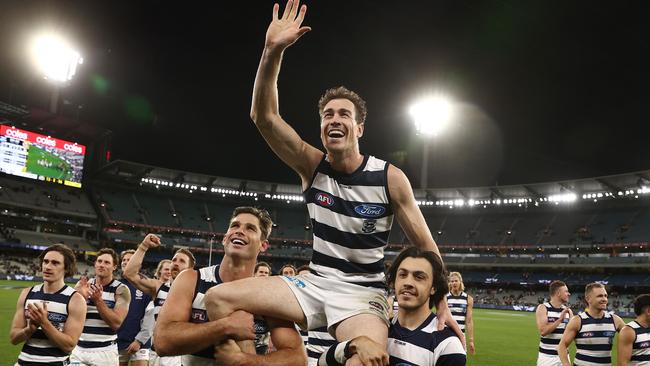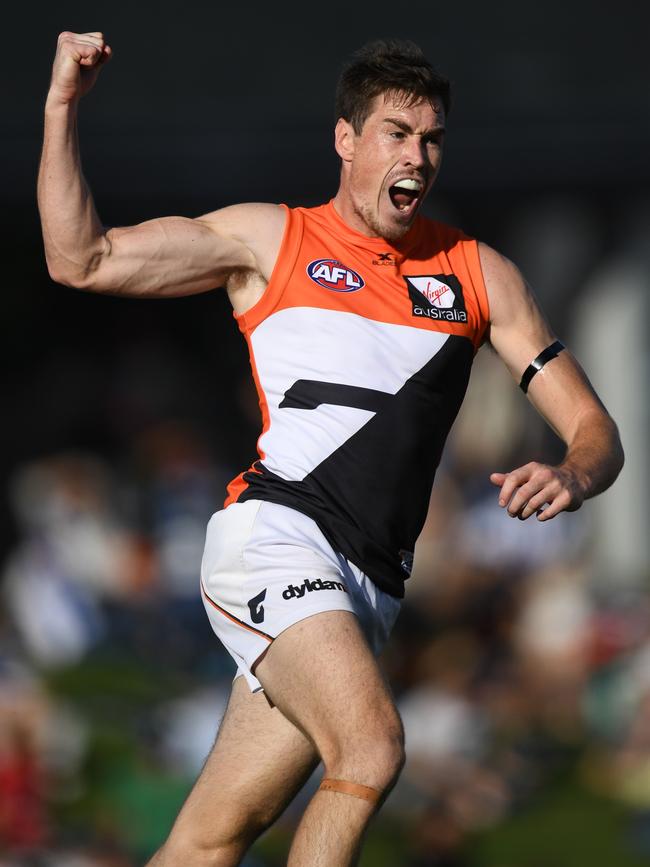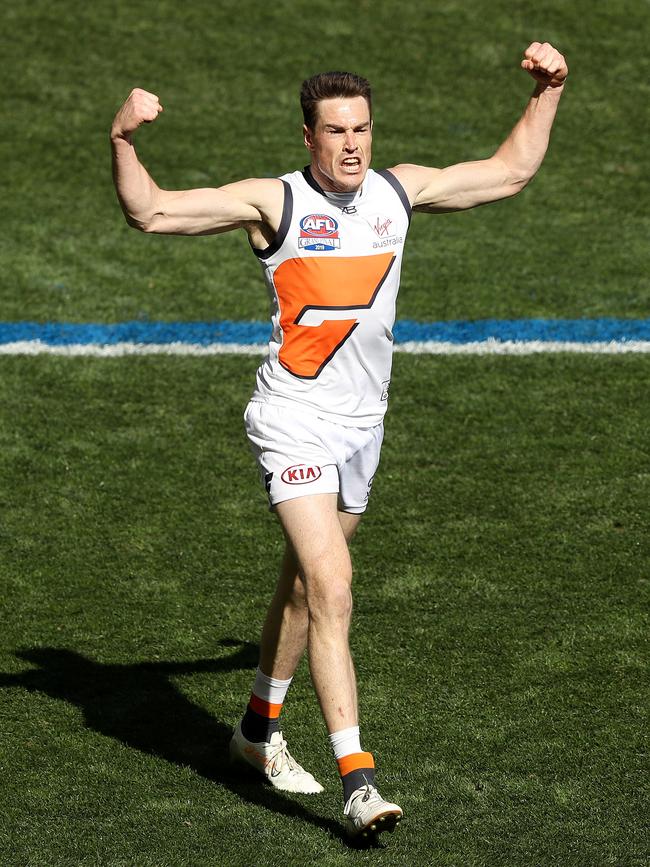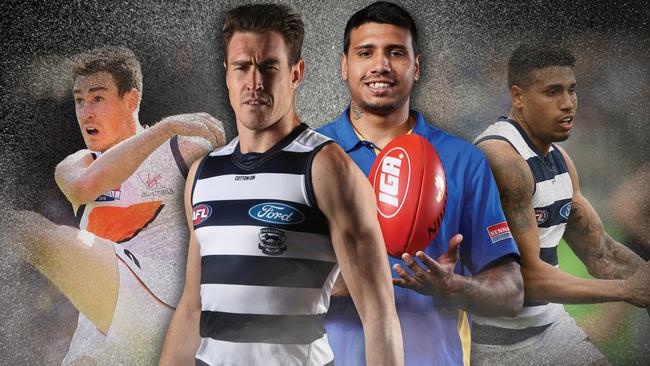For all the blockbuster trade negotiations that have gone down to the wire, few have been as testing as Geelong and GWS battling over Jeremy Cameron. Find out how the Cats pivoted from losing Tim Kelly to landing a superstar.
The trade negotiations may have continued a tick past the official AFL deadline.
For all of the deals which have gone down to the wire in the trade period, few have been as tense and as testing as Geelong’s trade with Greater Western Sydney over Jeremy Cameron in late 2020.
In the end, the Cats landed a marquee forward who in his second year in the hoops is playing arguably the best footy of his career, while the Giants received the bumper trade return they craved.
But until the last 90 seconds of the trade period, it could have all fallen over as the Giants maintained their strong position and Geelong considered whether it could safely walk Cameron through the draft.
Said one observer: “It literally came down to the last few seconds. That is how close things got.”
Ex-Geelong chief executive Brian Cook, who had swapped emails with the Giants in the taxing lead-up, was blunt about the frantic final few minutes.
“It was messy, really messy,” Cook said.
“There were some renegotiations in the last 90 seconds around the deal.
“It was a really tight, tough and challenging last two minutes to say the least.”
While the official paperwork might not have been finalised until after the deadline as both clubs wrangled with technology, cooler heads clearly prevailed on a blockbuster trade which looked dead mid-season.
Watch every blockbuster AFL match this weekend Live & Ad-Break Free In-Play on Kayo. New to Kayo? Start your free trial now >

The year before in late 2019, Geelong handed over Tim Kelly to West Coast for a mega trade return that included two first and two second-round draft picks which – when all added upon the draft value index – equalled pick No.2.
From a West Coast perspective, chief executive Trevor Nisbett recently admitted the move “hasn’t worked”.
Not to blame Kelly but injuries, the Covid pandemic and the team’s form more broadly have conspired against the Eagles, he said. “The people around him (Kelly) have fallen away and we haven’t had a fit, healthy squad. We haven’t gotten it right,” Nisbett said.
About five months after Kelly walked, Cameron kicked three goals in the Giants’ round 1 win over Geelong, fanning the flames of excitement among Geelong officials who hoped the tractor-driving goalkicker was their man.
But mid-season, the official response came through. Geelong hearts sank. Thanks, but no thanks was the message. “Jezza” was happy at the Giants.
So, the Cats went through the rest of 2020 thinking it was no-go. They were headed to the draft with the Kelly picks. They had selections 13 (which became 15 on draft night), 15 (18) and 20 (25) in their pocket.
But then another phone call came through in grand final week that season. A big one.
The tables had turned for Cameron after a tough year in the hub. The fisherman had been unhappy holed up in hotel rooms all year as Covid-19 took the football season by the throat. On the field, he had had a poor year by his lofty standards (24 goals from 17 games) and off the field Cameron had become as flat as a biscuit.



Fortunately for Geelong, Cameron was reconsidering his future and was open to pulling on the hoops. This was in the week of Geelong’s grand final loss to Richmond.
In a last-ditch bid, Giants chief executive Dave Matthews, assistant coach Steve Johnson and Cameron dined out at a fancy Sydney restaurant hoping the Coleman medallist would remain.
And for the bulk of that year, the Giants thought he would stay.
The AFL’s “Huckleberry Finn” had always seemed happy, connected and well-paid in the Harbour City, even if the last year of the deal had to be back-ended to about $1.5 million due to the Giants’ salary cap squeeze.
But Cameron had become “stressed out” and barely slept, he said, in the two months before his decision.
“There were so many nights when I went to sleep thinking, ‘I want to make the move’ and then I’d wake up and I wanted to be a Giant, that’s how intense it was for me,” Cameron said.
It was on Giants coach Leon Cameron’s couch that the popular forward dropped the news that he was off, setting the scene for one of the most difficult trade negotiations of recent years.
Cameron was a free agent, but the Giants were adamant they would match the Geelong bid. And they weren’t bluffing. They wanted a bumper trade for one of the game’s best forwards.
The Giants knew the Cats had the picks to give after closing the extraordinary Kelly deal the year before, and played a successful game of hard ball.
It meant the Cats had to cough up two of the three picks they had received for Kelly (15 and 18), plus their own first pick (25), or take the risk of walking him through to the draft.
But walking him through the draft was not guaranteed (unless it struck unofficial side deals with other clubs higher in the draft order) and stressful for all parties.
Essendon had three picks ahead of the Cats and could have taken him, but Cameron didn’t want to go to Tullamarine.
In the end, Geelong knew Cameron was worth more to the Cats’ premiership prospects than a trio of early draft picks, which even at the top end can be hit-and-miss.
So, when it came down to the nitty gritty, GWS demanded 15, 18 and 25.
The Cats agreed, but only if they received two second-rounders back. And that is when the clock started to tick down, and tensions began to rise. Would it be two firsts? Or three firsts and two seconds back?

The tricky part was Geelong had to wait for Essendon and GWS to agree on a deal for Jye Caldwell which saw the Bombers hand over two second-rounders to the Giants, paving way for the final dominoes to fall in the Cameron deal.
So the deal got done, by a whisker, even if memories are hazy about whether the process may have gone a touch over the trade deadline in the frantic final moments.
Fox Footy initially reported the deal was done for two first-round picks, before later confirming it was three firsts and two seconds back, such was the confusion or debate, around the specifics at the death.
As Cook said there was some “renegotiating” late.
If a blind eye was turned to the clock, the fact the two clubs were negotiating over the phone in extraordinary circumstances seemed fair enough.
Using the draft value index to count up the points, Geelong gave up the equivalent of pick No.12 to secure the freewheeling forward in one of the biggest trades the game has seen. In comparison, the Cats gave up picks Nos.12 and 16 for Brad Ottens a decade earlier in an arguably even sweeter deal which helped net the Cats three flags.
But the trade was not without a major hiccup in the first year as Cameron suffered three hamstring setbacks which capped his output and put a cloud over the move.
But Cameron benefited from a full pre-season leading into 2022.
It was only a green light on the Cameron move if Tom Hawkins agreed. But he saw how not only Cameron could help win them a flag, but also extend Hawkins’ career by helping lighten the load.
The proof is in the pudding as Hawkins is also in arguably career-best form.
THE FLIP SIDE
THE Giants were justified in pushing a hard bargain for Cameron, as three picks with two second rounders back may appear light-on for the form he is in, in hindsight.
The Dartmoor product ranks elite for disposals (16.2), marks (5.9), forward 50m marks (3.9), goals (2.9) and score involvements (7.9) across his 17 games (for 49 total goals) so far this season.
Aside from getting a rub on the hamstrings at every break in games, Cameron, 29, hasn’t missed a beat and the Cats are the new premiership favourites.
But what did the Giants turn those three high picks into?
GWS picked explosive hybrid forward Conor Stone with 15, hard-running wingman Ryan Angwin (who broke his leg) with pick 18, but it was the third pick which could be the masterstroke in it all.
GWS football boss Jason McCartney bundled pick 25 and pick 30 to swap with Collingwood for its first-round pick which ended up at three – netting the Giants star midfielder Finn Callaghan.
He is the man on the wing who could graduate into a smooth-as-silk onballer, despite a foot injury.



WHERE IT LEFT WEST COAST
AFTER missing out on Kelly in 2018, West Coast sold the farm for the gun midfielder in a move which saw the Eagles hand over two first round picks and two second-round selections.
That was pick 14, a future first-round pick (18), and choices 24 and 33 in exchange for the man who polled 24 Brownlow votes in his second season.
But Kelly hasn’t had anywhere near the same impact in blue and gold as he did in blue and white.
After booting 48 goals in his two years at the Cattery (and finishing fifth in the 2019 Brownlow Medal) Kelly has managed 16 goals in three years in the west.
His disposals have gone up from Geelong (23.5) to West Coast (24.2) and clearances (from 4.9 at Geelong to 5.3 at West Coast) but he has been trapped more in the back half, according to Champion Data.
According to Nisbett, Kelly was “playing great footy” but the situation facing West Coast was now “as difficult as I’ve experienced”.
Next week against Gold Coast, Kelly will play his 100th AFL match for a club in full rebuild mode.
From the Kelly deal, the Cats used 14 (which became 16) on promising local inside midfielder Cooper Stephens and then nabbed Sam De Koning, the man sitting second for the Rising Star award, with its own top pick which fell at 19.
The 33 went on Josh Jenkins from Adelaide as a back-up for Hawkins, but it was the 24 which was the genius key cog in turning Kelly into Cameron.
In a deal which raised eyebrows at the time, the Cats traded 24 (became 27) to Gold Coast (which they used to draft Jeremy Sharp) for the Suns’ 2020 mid-first round priority pick.
That Gold Coast pick was the pick No.15 which Geelong then packaged up the following year with No.18 and No.25 to seal the transfer for Cameron. It was a six-year deal worth about $900,000 a season.
And the blockbuster deal, as tough as it was for everyone at the time, has unequivocally been worth it.


Add your comment to this story
To join the conversation, please log in. Don't have an account? Register
Join the conversation, you are commenting as Logout
Made By Marcia: The secret ingredient to Roos’ greatness
Darren Crocker is the man driving North Melbourne’s unparalleled success. But he, or the team, couldn’t have done it without someone special – his wife, Marcia, and the famous weekly award.
Roos open up on ‘difficult’ selection call
The North Melbourne coach was forced to endure one of the toughest conversations of his career after making a difficult call.